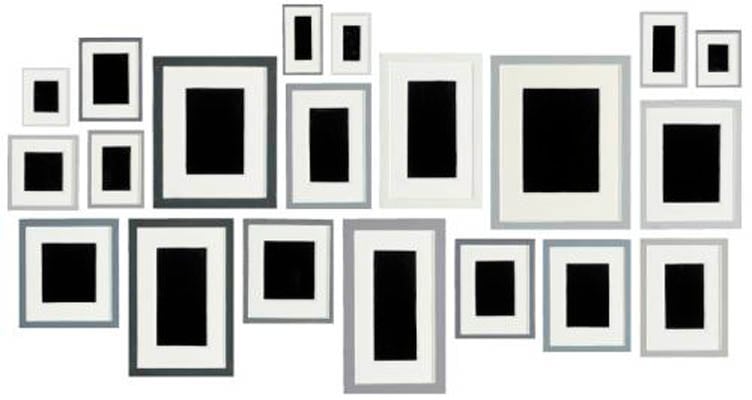20 Surrogates
1982 - Sculpture (Sculpture)
Allan McCollum
In the work titled The Glossies (1980), an affinity for photography manifested itself before McCollum actually began to use photography as a medium. The Glossies are drawings, rectangular forms applied with blank ink and watercolors, which fill up the sheets parallel to the edges except for a small margin. Finally, the whole paper is covered with an adhesive plastic laminate, which gives it the shiny surface of a photograph. The drawing as original artistic expression is employed as a sign for photography. In this respect, The Glossies marks a decisive transition to the “Plaster Surrogates”, a multi-phase work, which McCollum began to create in 1982. Discussing the Plaster Surrogates in a 1985 interview, McCollum described his practice as “a sort of ‘working to rule’”: a job action in which workers do precisely and only what is required contractually, both refusing excess work and excessively observing rules and regulations. “In a sense, I’m doing just the minimum that is required of an artist and no more.” Each and every Surrogate is signed dated and numbered. Although McCollum works with assistants, he insists on painting the outer edge of every black center and the inner edge of every border. No two surrogates are identical; all those of the same dimensions have slightly different colored borders and vice versa. There is nothing false about the objects themselves. McCollum doesn’t employ illusionism or trompe l’oeil. His Surrogates aren’t forgeries of paintings. They’re not even paintings – only plaster objects, which may, at a distance, resemble framed images. The artist proceeded to hang his Surrogate Paintings in larger groups and in a relatively order less way, side by side and one beneath the other. By his increase of quantity and the effect of repetition, he intended likewise to interpret this exaggerated idea of an installation as a sign and to exclude any kind of view, which emphasizes the importance of the single picture. The surrogates, via their reduced attributes and their relentless sameness, started working to render the gallery into a quasi-theatrical space which seemed to “stand for” a gallery; and by extension, this rendered the artist into a caricature of the artist, the viewers performers.
Allan McCollum neither superimposes the conditions of industrial production as artistic practice nor attempts to raise them, in a heroic gesture, to the status of high art. The starting point of his art generally surrounds the idea of a sign. He frames the sign inside of realm of the significant characteristics of the total quantity of all pictures in general. These considerations are the result of an inconsistency of art production in relation to culture at large and the function it fulfills. This function is determined by the fact that in the economic system of a consumer society, the artwork becomes a commodity.
Colors:
Related works featuring themes of: » Art That Plays With Scale, » Color Photography, » Contemporary Conceptualism, » Contemporary Participation, » American

© » KADIST
Jennifer Bornstein
1994Collectors’ Favorites is an episode of local cable program from the mid-1990s in which ordinary people were invited to present their personal collections—a concept that in many ways anticipates current reality TV shows and internet videos...

© » KADIST
Francis Alÿs
2006This series of small drawings is executed with varying materials—pen, ink, colored pencil, charcoal, and masking tape—on architect’s tracing paper...

© » KADIST
Nicolás Paris
2012Nicolas Paris studied architecture and worked as an elementary school teacher before he decided to become an artist...

© » KADIST
Du Zhenjun
2010The Tower of Babel is an installation of large-format photographs that forces the audience to occupy a central position through its monumental scale...

© » KADIST
Choi Jeong-Hwa
2008The application of bright colors and kitsch materials in Flower Tree manifests a playful comment on the influence of popular culture and urban lifestyle...

© » KADIST
Félix González-Torres
1992Behind the simplicity and beauty of this untitled photograph of a brilliantly-colored flowerbed by Félix González-Torres are two remarkable stories of love, loss, and resilience...

© » KADIST
Yee I-Lann
2013Sarcastically titled to call attention to the problematic notions underlying colonialism, this photograph shows hundreds of Native Malaysians seated quietly behind one of their colonial oppressors...

© » KADIST
Douglas Gordon
2004Douglas Gordon’s single-channel video The Left Hand Can’t See That The Right Hand is Blind, captures an unfolding scene between two hands in leather gloves—at first seemingly comfortable to be entwined, and later, engaged in a struggle...

© » KADIST
Robert Therrien
1985In No Title (Blue Chapel) Therrien has reduced the image of a chapel to a polygon...

© » KADIST
Daniel Joseph Martinez
2005Martinez’s sculpture A meditation on the possibility… of romantic love or where you goin’ with that gun in your hand , Bobby Seale and Huey Newton discuss the relationship between expressionism and social reality in Hitler’s painting depicts the legendary Black Panther leaders Huey P...

© » KADIST
Yee I-Lann
20207-headed Lalandau Hat by Yee I-Lann is an intricately woven sculpture evoking the ceremonial headdress worn by Murut men in Borneo...

© » KADIST
Lucas Blalock
2013Blalock resists the immediacy that we have come to expect from photography—that each photograph should communicate its message without delay...

© » KADIST
Yang Zhenzhong
2012Peasant Sensation Passing Through Flesh – 3 consists of a massage chair fixed to a wall...

© » KADIST
Oded Hirsch
2012Oded Hirsch’s video work Nothing New (2012) utilizes seemingly absurdist tropes to raise more trenchant questions about communal action and collective identity in modern day Israel...

© » KADIST
Piero Golia
2007Golia’s Untitled 3 is an installation in which a mechanical device is programmed to shoot clay pigeons that are thrown up in front of a white wall...





